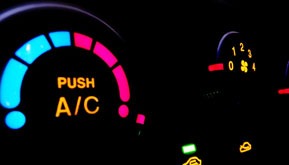An air conditioner is an essential appliance that cools our homes and controls the air temperature, which is vital to our daily lives. We might take it now for granted, but imagine how can we survive the scorching heat of summer if there is no cooling device anywhere? Fanning is never enough when temperatures rise up to triple digits.
Our ancestors had to deal with it manually. Efforts of cooling the air started as early as 3,000 years ago when the Chinese invented the hand fan.
The ancient Romans also had their share of attempts to control indoor temperatures. The wealthy citizens took advantage of the aqueduct system and circulated the cool water through the walls of their houses. During the third century summer, things went overboard when the eccentric Roman Emperor Elagabalus sent 1,000 slaves to the mountains to fetch snow to build a mountain of snow in the garden next to his villa to keep cool during the summer.
During the 2nd century, a Chinese inventor named Ding Huan built the room-sized rotary fan for air conditioning that is powered by the hand of prisoners. There were also adjustments made to architecture before the era of modern temperature control, like in Middle Eastern construction when windows were facing away from the sun and large buildings featured wind towers designed to catch and circulate air breezes.

In 1842, a physician from Florida named John Gorrie proposed the idea of cooling hospitals and cities to keep patients more comfortable and to avoid diseases like malaria. He used compressor technology to create ice, which he used to cool the air for his patients in his Florida hospital. Even though his prototype performed irregularly, he received a patent for his ice-making machine in 1851. He even envisioned centralized air conditioning for cities, but his creation failed to develop it for selling in the market due to the death of his chief financial backer. However, his invention laid the foundation for modern air conditioning and refrigeration, and his vision of having commonplace air conditioning was made possible after 50 years.
After President James Garfield was shot by an assassin in 1881, the naval engineers built a cooling device filled with ice water-soaked cloth and blown by a fan to keep him cool and comfortable while trying to recover. Like Elagabalus, his comfort required a lot of effort – his caretakers used half a million pounds of ice in two months, but the president still died.
The game changer for this problem is the invention of electricity. When Nikola Tesla developed the alternating current motors, it paved the way for the invention of oscillating fans in the early 20th century. But still, it had no effect with humidity.
Artificial cooling really started in 1902 when Willis Carrier invented the first electrical air conditioning unit. While working for the Buffalo Forge Company, Carrier was asked to solve a humidity problem that causes magazine pages to wrinkle at Sackett-Wilhelms Lithographing and Publishing Company in Brooklyn. He conducted a series of experiments and designed a system that controlled humidity using cooling coils. Carrier secured a patent for it and continued refining his technology. Because of the success of his invention, demand increased. He eventually left Buffalo Forge to form his own company, The Carrier Air Conditioning Company of America.

In 1922, Carrier created a well-designed cooling system designed for theaters at the Metropolitan Theater in Los Angeles. The system pumped cool air through higher vents for better humidity. He also followed up with the invention of the centrifugal chiller, which publicly debuted at the Rivoli Theater in Times Square. It had fewer parts and compressor stages than his previous creations had increased reliability and had a lower price than other large-scale air conditioners. Later on, people flocked into the air-conditioned movie theaters on hot summer days, causing the summer blockbuster.
By the 1930s to 1940s, the use of air conditioning spread to offices, rail cars, and department stores, increasing the productivity of workers during the summer. However, despite improvements in the technology, these systems remained expensive and too big for typical homes.
The first time air conditioning was used in a house was in1914. Charles Gates’ mansion in Minneapolis contained an air conditioner that was approximately 7 feet high, 6 feet wide and 20 feet long. In 1929, Frigidaire introduced a new split-system room cooler that was small enough for homes and was shaped like a radio cabinet. It was still expensive and heavy, and it needed a separate, remotely controlled condensing unit. This was improved by General Electric’s Frank Faust and developed a self-contained room cooler.
During this time, General Motors’ Albert Henne, Thomas Midgley, and Robert McNary synthesized chlorofluorocarbon (CFC) coolants, also known as Freon. It improved the safety of air conditioners as it was the first non-flammable refrigerating fluid, as compared to the toxic and flammable gases used previously like ammonia, methyl chloride, and propane.
In 1931, home cooling systems got smaller when H.H. Schultz and J.Q. Sherman invented an air conditioning unit that could be placed on a window ledge. Their device reached the market in 1932 but was not widely purchased because it cost around $10,000 to $50,000 that time – an amount that is equivalent to $120,000 to $600,000 today. Henry Galson went on to create a more compact, cheaper version of the window air conditioner. His unit got built by several manufacturers and by 1947, 43,000 of his device were sold. This paved the way for more widespread use of air conditioning inside the home.
Cars utilized the air conditioner starting 1939. Packard pioneered in providing AC’s for vehicles, but the drivers were required to stop the engine, open the hood and disconnect a compressor belt of their air-conditioned cars when passengers got so cold.
By 1965, only 10% of homes in the United States had air conditioning, according to the Carrier Corporation. But in 2015, the Energy Information Administration reports that 87% of households in the country are using air conditioners. Cities that were unbearable during the summer became more attractive places to live and work due to the use of reliable cooling systems.
As years came to pass, experts had discovered that most cooling systems that the use of CFC or Freon was causing depletion in the ozone layer. It was also eating up a lot of energy, significantly increasing energy bills. In 1992, the Department of Energy issued a conservation standard and an alternative refrigeration evaluation program to generate energy bill savings, and find alternatives to CFC and its components so those greenhouse gas emissions that damage the ozone layer would be reduced. The program helped consumers to save money and energy. In fact, new air conditioners today use around 50% less energy than those units sold during 1990.
By 1994, Freon was banned in several countries, and by the next year, the manufacturing of CFC was given an end. Newer, ozone-friendly refrigerants have been developed such as the R-11, R-12, R-22, and R-410a, among others. Air conditioner brands like Carrier and Honeywell developed coolants that are more environmentally-friendly. Hydrofluorocarbon (HFC) coolants were used as an alternative by many, but it was also linked to climate change problems.
Nowadays, the Department of Energy’s program is working on the next biggest improvement in air conditioning which is the non-vapor compression technology – a totally cooler choice because it won’t use HFCs and it could reduce energy consumption to greater levels.

